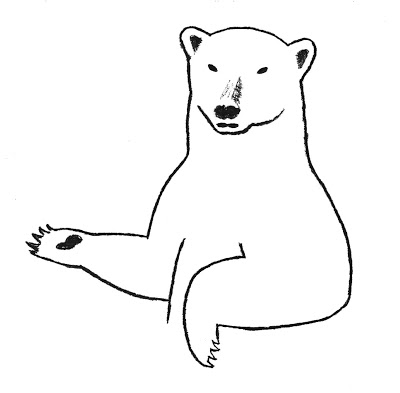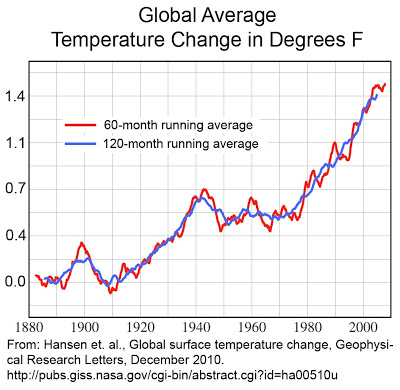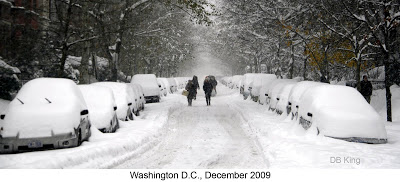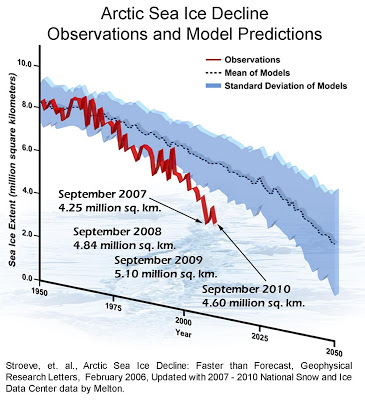
It is colder because it is warming
On a warmer planet, winter weather becomes more volatile. The extremes get more extreme.
By Bruce Melton / The Rag Blog / January 13, 2010
Global warming refers to climate, not weather. Snowpocalypses and icetastrophes are not climate, even when year after year they cover subcontinental size areas on multiple continents.
They are however, very similar to the climate that we had before the 1990s. So why do we keep having these blizzasters if we are supposed to be warming?
Even three years of snowmegeddons cannot keep our climate from warming. Even when large areas of multiple continents are involved. There is one little problem though… Blizzards, no matter how cataclysmic, are still just weather. Climate is much, much bigger than weather.
The academic world has started to unravel the clues about why we are seeing more extreme winter weather in some places, and the answers are the same as the climate models have been telling us. On a warmer planet, winter weather becomes more volatile. The extremes get more extreme. Not necessarily extremely cold, but it only has to be below freezing to snow. And the warmer it is, the more snow can fall. Warmer air holds more moisture — it is the reverse of “it is too cold to snow.”
A paper in the journal The Cryosphere Discussion (cryosphere is that part of the Earth that is covered with ice), by Mark Serreze at the National Snow and Ice Data Center in Boulder Colorado says that the Arctic has warmed 5.4 to 9 degrees F, or five to 10 times the global average of 0.9 degrees. This is just for warming relative to the 1970 to 2007 average time period. (1).
The reason that the Arctic has warmed so much more than the rest of the planet is called Arctic amplification, and the same thing is happening in high altitude mountains around the world. This “Arctic amplification” is nothing more than additional warming caused by the loss of snow and ice on a warmer planet. The scientists call it a warming feedback.
A “feedback” happens when a little bit of warming melts a little bit of ice. Ice reflects sunlight harmlessly back into space without causing warming. Sunlight striking dirt or rocks, water or vegetation, warms that object. This warming is trapped by the greenhouse effect and causes more ice to melt.
This mostly explains why the Arctic is warming so much more than the rest of the world. (The Antarctic is different because it is surrounded by ocean and has a completely different set of dynamics than the Arctic, which is surrounded by land.)
So, the Arctic is warming a lot more than the rest of the planet — how does this make winters colder? First: It has not really been earth-shattering cold. The winter temperature across the U.S. last year (2009) ranked 18th coldest out of 115 years, but for the entire year the U.S., ranked 34th warmest out of 115 years of records.
The year 2008 ranked 38th warmest of 114. and 2010 ranked 18th warmest through November. Northern Canada however had its second warmest winter ever recorded in 2009 and the combined global average temperature was the fifth warmest ever recorded. This year (2010) tied 1998 as the warmest year ever recorded. (2)
Just because it was one of the coldest winters in decades in some parts of the U.S. for the last few years does not mean it was very cold. It means that it has been warmer than normal for decades.

Beginning in the late 1970s, our climate really started to warm. The warming has only been a little more than a degree, but most of the warming comes in the winter. So we have been lulled into complacency by decades of warmer than usual temperatures, and even warmer winters. I remember in the 1960s and 70s when I was a kid, I was fascinated when arctic air invaded the northern tier of the United States and temperatures plummeted to 40 below and just hung there for weeks. That just does not happen anymore
The latest global temperature analysis from the main U.S. climate modeling agency, NASA’s Goddard Institute for Space Studies, looks at the long-term running average global temperature. Using a running average smooths out the chaos of monthly weather changes. This technique plots successive averages instead of each individual record point. (3)
A running average removes a lot of the chaos in the temperature records. This is a different way of looking at the numbers that acts like a fine-tuning knob. It makes the “picture” clearer. It allows the “music” to be heard without static. That static is the chaos of weather.
In a single day, the temperature at any given spot can change as much as 40 degrees or more. In a year at any given place, the temperature can change over 100 degrees or more. This natural variability makes it difficult to see the small changes associated with climate change. But these small changes can have tremendous impacts.

Think of our atmosphere as a pot of water on the stove. After a little bit of warming, movement can be seen in the water. These are convection currents. The same thing happens in our atmosphere, only a little bit of convection can create a big thunderstorm.
The warming we have seen because of the unintended carbon dioxide enrichment of our atmosphere is less than two degrees averaged across the globe. This may only be a couple of degrees, but it is a really big deal.
The difference in global temperature between the depths of the ice ages and the warmest it has been in the last 10 million years is only about 9 degrees F. The global temperature today is within one and a half degrees of being as warm as it has been in 1.35 million years. (4) By the end of the century, the global temperature will be similar to when the dinosaurs were around and sea level was 200 feet higher. (5)
But one of the really dangerous things about climate change, published in Thresholds of Climate Change in Ecosystems, by the U.S. Geological Survey, National Oceanic and Atmospheric Administration, National Science Foundation, U.S. Department of Agriculture, U.S. Forest Service, U.S. Department of Energy, and the U.S. Environmental Protection Agency, under the U.S. Climate Change Science Program, in January 2009, is that just a few degrees of change is all it takes to push an ecosystem over the edge. (6)
It turns out our weather is highly sensitive to a few degrees of change as well. The Beaufort High is a semi-permanent, seasonal weather phenomenon similar to the Bermuda High or the Aleutian Low. (The Beaufort High forms over the Beaufort Sea in the Arctic, north of the border between Alaska and Northwest Territories.)
These big high or low-pressure areas form every year, and hang around for months and months. The Bermuda High is most notable in the summer and the Aleutian Low and Beaufort High in winter. They are responsible for influencing weather patterns across the Northern Hemisphere because they shape and change the path of the jet stream.
An article published in the Journal of Climate, led by a researcher from Duke University, has found that the Beaufort High has recently intensified. This is something that the models have been predicting because of planetary warming, and now it has happened. What it means for you and me is that the jet stream path has changed. The Beaufort High, because it is larger now, pushes the jet stream further south. It just so happens that it pushes it south right into central and northeastern North America. (7)
This high-pressure system has increased in size because there is more heat in the Arctic now. This heat is especially apparent in the fall and early winter, because arctic sea ice coverage has fallen so precipitously. Even when sea ice begins to regrow in the fall, the impacts of the extra heat hang around.
This extra heat hanging around is a normal seasonal temperature lag just like we see everywhere else. Maximum heating in the summer and maximum cooling in the winter are not centered on the longest or shortest day of the year. The temperature lags behind. It takes Mother Earth some time to adjust. So the big Beaufort High impacts Northern Hemisphere weather far into the winter.
The jet stream has changed and it is throwing arctic storms further south. Even though arctic temperatures have risen five to 10 times as much as the rest of globe, the Arctic blasts are still cold. And remember that pot of water we left on the stove? A warmer atmosphere is more energetic; the storms are more intense. They may not be colder, but they can make more snow because they have more energy.
Even people like me, who grew up in south Texas with citrus trees, have heard that it can be too cold to snow. This old saying reflects a simple scientific principle. As air cools, it can hold less moisture. When it gets colder, it snows less and less because there is less and less moisture in the air. But warm it up to nearer to the freezing point and the amount of snow increases.
So, the Beaufort High is kicking arctic storms further to the south because the jet stream has changed, and those storms are more energetic because it is warmer in the Arctic. We seem to be getting clobbered with cold, when in reality, the Arctic has warmed a tremendous amount. This is one of those things that makes climate change so counterintuitive.
Last month was number 310 in a row where the average global temperature was above the 20th century average. That’s 25 years and 10 months. Last winter’s NOAA Climate Extremes Index was six percent above average (nothing to write home about.) Mid-March ice coverage of the Great Lakes was at an all-time low, and North American snow cover for April was the smallest ever recorded in 2010. (8)

The relatively cooler winter in the U.S. northeast and Europe in 2005-6 has also been recreated in the climate modeling world. The climate science guys have been predicting that this would happen, but until now these predictions have not been confirmed. Using actual sea ice coverage, a study led by Vladimir Petoukhov at the Potsdam Institute for Climate Impact Research in Germany, has recreated the extreme winter events of the northeastern U.S. and Europe in the winter of 2005-6. (9)
The cause is warming in the Arctic. The decrease in Arctic sea ice caused by warming is another natural phenomenon that has a feedback component. More warming means more melt of course. Water absorbs nearly 90 percent of the sun’s light and changes it into heat. Snow and ice reflect up to 90 percent of the sun’s light harmlessly back into space without it being changed into heat. (Water absorbs eight times more heat than snow and ice.)
This extra heat hangs around to continue the feedback. Summer melt then extends further into the fall; warmer ocean waters prevent thicker ice from forming and because the freeze up started later, there is less time for thicker ice to form. Warmer temperatures also cause more snow, which insulates sea ice from the cold temperatures above. The extra warmth increases high pressure over the Arctic, which increases the energy level of storms and the jet stream then pushes Arctic weather further south than normal. Clear as mud.
These scientists are calling this the “new normal.” They now say that the chance of having extreme winter weather has increased by three times because of this series of Arctic warming feedbacks. Only the winter of 2005-6 has been modeled so far, but the same conditions in the Arctic continue as the continued stormy winters in the Northeast and Europe attest.
The models also show that this change in global weather patterns in these two areas tends to disappear as sea ice melt becomes more complete. The reasoning is as yet unclear, but it likely has to do with the jet stream unbuckling, or by the time the Arctic is ice free it will be too warm for big snowstorms in areas where we normally have them.

The National Oceanic and Atmospheric Administration (NOAA) has a website called Future of Arctic Sea Ice and Global Impacts. In addition to the above papers, NOAA lists the University of Washington, Japan Agency for Marine Earth Science and Technology, University of Wisconsin, Institute of Marine and Coastal Sciences, Rutgers University, University of Illinois, National Center for Atmospheric Research, and the Lamont Doherty Earth Observatory of Columbia University as institutions that have published evidence showing that “warming really does make it colder.” (10)
But the list does not stop here. Winter snowmelt in the Arctic has been shown to be starting 15 days earlier and ending 30 days earlier over the past 30 years. (11) Arctic sea ice has even been shown to have been present, even in the summer season, for 14 million years; meaning that the last time the arctic was ice free in summer was 14 million years ago. (12)
Another researcher at the National Snow and Ice Data Center has shown us that Arctic sea ice is declining much more rapidly than the supercomputer models have predicted. Comparing real world measurements of sea ice coverage to Intergovernmental Panel on Climate Change scenarios and model predictions, sea ice coverage today is as low as it is projected to be, under the worst-case scenarios, in the year 2080. This is 70 years ahead of schedule. (13)
One of the biggies in climate science, however, is that a researcher at the Center for Earth Observation Science at the University of Manitoba in Canada has found that the Arctic Sea is functionally ice-free in the summer season now — today. (This was in 2009 when this paper was published.) (14)
This team of Canadian scientists, led by David Barber, whose Arctic expedition discoveries were published in the journal Geophysical Research Letters, says they found a much different sea icescape in the Southern Beaufort Sea than anticipated based on their satellite ice sensors.
The satellites had shown 70 to 90 percent coverage of multi-year or thick first-year ice throughout most of the southern Beaufort Sea in the deep water of the Canada Basin. When the crew visited the area in their icebreaker, the Amundsen, what they found was heavily decayed, very small remnant multi-year and first-year flows mixed with brash and bergy bits. In other words, they found a giant Slurpee where there was supposed to have been ice that was nearly impassible to all but a few nuclear icebreakers.
This greatly surprised the team, as they cruised through the rotten ice of the Beaufort Sea at top speed (15 miles an hour.) The Amundsen was designed to break three-foot thick sea ice at a speed of three and a half miles per hour. The ice they found was so rotten that the Amundsen could break 19 to 26 feet of rotten multi-year ice at three and a half miles an hour.
When the ice sensing satellites were put into operation, these warmer conditions that we are seeing now did not exist, or it was still cold enough, year-long, to keep the ice from beginning to disintegrate like it is doing now. The ice then was as hard as integral calculus and twice as stubborn. Since then we have seen what has apparently been the crossing of a threshold in terms of Arctic sea ice melt. What the science guys and girls did not know back then, was that the rotten Slurpee ice looks very similar to the plain old hard stuff that has been there for 14 million years.
The expedition was well described in an article interviewing Barber by Reuters News Service: Barber spoke shortly after returning from an expedition that sought — and largely failed to find — a huge multi-year ice pack that should have been in the Beaufort Sea off the Canadian coastal town of Tuktoyaktuk. Instead, his icebreaker found hundreds of miles of what he called “rotten ice” — 20-inch thin layers of fresh ice covering small chunks of older ice.
“From a practical perspective, if you want to ship across the pole, you’re concerned about multi-year sea ice. You’re not concerned about this rotten stuff we were doing 15 miles per hour through. It’s easy to navigate. I would argue that we almost have a seasonally ice-free Arctic now, because multi-year sea ice is the barrier to the use and development of the Arctic,” said Barber. (15)
[Bruce Melton is a registered professional engineer, environmental researcher, trained outreach specialist, and environmental filmmaker. He has been translating and interpreting scholarly science publications for two decades. His main mission is filming and reporting on the impacts of climate changes happening now, unknown to the greater portion of society. Austin, Texas is his home. His writing and films are on his website.]
- See previous articles by Bruce Melton on The Rag Blog.
References:
(1) Arctic Amplification: How the Arctic warms so much more rapidly than the rest of the world…
Serreze, et .al., The emergence of surface based Arctic amplification, The Cryosphere Discussion, February 2009.
http://www.the-cryosphere.net/3/11/2009/tc-3-11-2009.pdf
(2) National Climatic Data Center: Average temperatures for the U.S. and the world…
http://www.ncdc.noaa.gov/temp-and-precip/maps.php?ts=3&year=2010&month=2&imgs[]=Nationaltrank&submitted=Submit
(3) Running average temperature… Hansen et. al., Global Surface Temperature Change, Geophysical Research Letters, December 14, 2010.
http://pubs.giss.nasa.gov/cgi-bin/abstract.cgi?id=ha00510u
(4) Global Temperature is within one degree of being as warm as it has been in 1.35 million years… Hansen, et. al. Global temperature change, Proceedings of the National Academy of Sciences, September, 2006.
http://www.pnas.org/content/103/39/14288.full
(5) By the end of the century, global the global temperature will be similar to when the dinosaurs were around and sea level was 200 feet higher…
Church et. al., Understanding Sea Level Rise and Variablility (2010), Australia’s Commonwealth Scientific and Industrial Research Organization (CSIRO).
http://www.cmar.csiro.au/sealevel/sl_pubs_sl_book.html
(6) Just a few degrees of change is all it takes to push an ecosystem over the edge… Thresholds of Climate Change in Ecosystems, U. S Climate Change Science Program, U.S. Geological Survey, National Oceanic and Atmospheric Administration, National Science Foundation, U.S. Department of Agriculture, U.S. Forest Service, U.S. Department of Energy and the U.S. Environmental Protection Agency, U.S. Climate Change Science Program, January 2009.
http://www.climatescience.gov/Library/sap/sap4-2/default.php
(7) The Beaufort High… Li, et. al., Changes to the North Atlantic Subtropical High and Its Role in the Intensification of Summer Rainfall Variability in the Southeastern United States, Journal of Climate, October 2010.
Duke Press Release: http://www.nicholas.duke.edu/news/increasingly-variable-summer-rainfall-in-southeast-linked-to-climate-change
(8) 308th consecutive month above average…
http://www.ncdc.noaa.gov/sotc/?report=global
(9) The Winter of 2005-6 recreated by climate models… Petoukhov and Semenov, A link between reduced Barents-Kara sea ice and cold winter extremes over northern continents, Journal of Geophysical Research, November 2010.
http://www.agu.org/pubs/crossref/2010/2009JD013568.shtml
(10) NOAA has a website called Future of Arctic Sea Ice and Global Impacts…
http://www.arctic.noaa.gov/future/index_impacts.html#event
(11) Arctic snowmelt 15 to 30 days earlier… Tedesco, et. al., Pan Arctic terrestrial snowmelt trends, 1979 to 2008, from spaceborne passive microwave data, Geophysical Research Letters, November 2009.
http://www.agu.org/journals/ABS/2009/2009GL039672.shtml
(12) Arctic sea ice coverage, 14 million years…
Darby, Arctic perennial ice cover over the last 14 million years, Paleoceanography, February 2008.
http://www.agu.org/journals/ABS/2009/2009GL039672.shtml
(13) Arctic sea ice melt 70 years ahead of schedule… Stroeve, et. al., Arctic Sea Ice Decline Faster than Forecast, Geophysical Research Letters, vol. 34, 2007.
http://www.agu.org/pubs/crossref/2007…/2007GL029703.shtml
IPCC Fourth Assessment Report, Technical Basis, Chapter 10 Global Climate Projections, November 2007, page 771.
(14) Arctic is essential ice-free now… Barber et. al., Perennial pack ice in the southern Beaufort Sea was not as it appeared in the summer of 2009, Geophysical Research Letters, December 2009.
http://www.arcus.org/search/seaiceoutlook/2009_outlook/summary_report/downloads/pan-arctic/pdf/barber-etal-2009-summary-report.pdf
(15) Barber Interview from Reuters News Service…
http://www.reuters.com/article/idUSTRE59S3LT20091029?sp=true

















